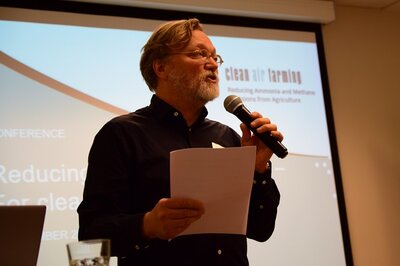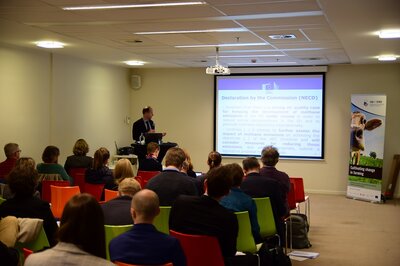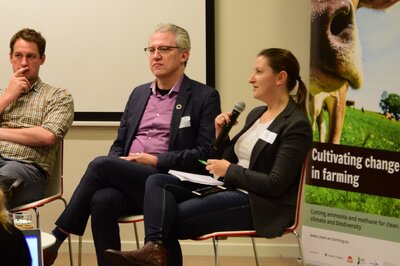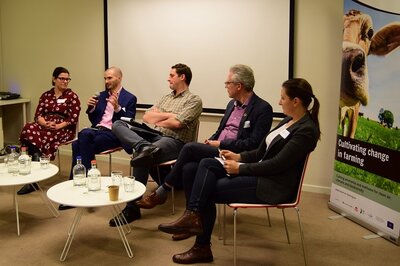Reducing methane emissions – for cleaner air and climate
Conference on 7 November 2019 in Brussels
Impacts and scenarios of methane emissions
Methane is a major greenhouse gas and responsible for 24% of global warming to date. Within the EU, 54% of methane comes from Agriculture - of this: enteric fermentation is responsible for about 81%, manure for 17%, while contributions from rice cultivation are about 1%. In the EU, the largest CH4 emitting sector is agriculture, and in particular livestock. Other important sources of CH4 are energy production: over the last 30 years, with the reduction of coal production in Europe, fugitive emissions from coal mining has declined considerably (77%), while those from natural gas operations increased (by 16%) and are subject to high uncertainty.
The European Environment Agency Air Quality in Europe report 2019 highlights that 14,000 premature deaths were caused by Ozone in 2016; the number of Years of Life Loss caused by ozone is also included there, 149,000. The EU Member States with the largest health impacts are Italy, Germany, Spain, France and Poland. The countries with the highest rates of Years of Life Lost per 100 000 inhabitants due to ozone pollution are Greece and Italy.
Unabated, global anthropogenic methane emissions could increase by 35 to 100% by 2050 for a range of pessimistic scenarios causing 40,000 (+12%) to 90,000 (+26%) more premature deaths due to ozone compared to present day ozone levels.
By contrast, optimistic sustainability scenarios project methane emission reductions of up to 50% by 2050 saving worldwide 30,000 (9%) to 40,000 ( 12%) lives.
Except for most stringent mitigation scenarios, the relative contribution of methane to surface ozone (and its environmental impacts) will increase in the next decades.
Furthermore, ozone affects ecosystems and agricultural crops. In 2016, the Critical Level (CL) for the concentration of ozone was exceeded in 61% of the total forest area in the EEA 33. An analysis of ozone damage to vegetation (visible injury, growth and yield effects) in 17 European countries showed that effects were better correlated with modelled stomatal flux than AOT40[1]. Stomatal flux provides a good indication of ozone effects on plants in the northern third of Europe. Using a metric related to the flux, crop yield losses of the order of 13-14 % in Europe are estimated (ETC/ACM, 2018c).
Ozone pollution in the EU is not only due to methane, several other precursors come into play (NOx, VOC in particular). But conisdering the extent of the problem, all sources (and precursors) of ozone need to be tackled, including CH4.
Furthermore, peak ozone episode are strongly linked to weather conditions and favoured by warm weather, which are occuring more and more with climate change.
Current Policies
On the air quality and air emissions side, the European Comission continues to ensure the implementation of the existing pieces of legislation (Ambient Air Quality Directive,AAQD, and National Emissions Ceilings Directive in particular, NECD). Thus, by pressing member states to reduce their emissions of air pollutants under the NECD and to ensure that AAQD standards are respected, it delivers strong incentives to also reduce methane, since several measures bring co-benefits between pollutants.
- There are multiple windows of opportunity – major ones are: the European Green Deal and Farm to Fork Strategy, the 8th Environmental Action Programme and the Agenda 2030 and its implementation.
- the commission commited itself to the vision of a Climate neutral continent, accompanied by a zero pollution strategy
The coherence of policies is required: Agriculture – air quality – climate – energy: all must be seen and treated together.
Apart from the European Emission Trading Scheme, the EU’s Long-term climate strategy does not tell how policies are to be designed to make people, firms and agencies act in accordance with the plan. After legally binding targets have been adopted, it will be up to Member States and the EU to find appropriate ways to act on it.
International: Under the Air Convention (LRTAP), the parties agreed during the last Working Group on Strategy and Review meeting on a proposed list of topics for discussion and consideration within the upcoming review of the amended Gothenburg Protocol. This list includes methane as one of the issues that would need to be further examined and discussed during this review process. Methane was already agreed as a topic of interest within the Long-Term Strategy for post-2020, adopted in December 2018, notably because of its role as precursor to ozone.
The EU supports the inclusion of methane as a topic in the review exercise and looks forwards to the next steps of the upcoming review – expected to be initiated by the Executive Body in December 2019. The review is an evaluation process which may or may not lead to the conclusion that the Gothenburg Protocol would need to be updated, complemented or clarified in any way.
Outlook
For methane, additional technical mitigation potential is limited but inexpensive. Sustainable scenarios assume structural changes in the energy, waste and agricultural sectors, together with the implementation of all currently available emission abatement technologies to be on track for Paris Agreement.
After a transition away from fossil fuels, the agricultural sector will be key to a climate neutral Europe. Globally, dedicated efforts needed to reduce methane emissions from all sources using existing technology to limit warming in the short-term.
In the long-term, non-CO2 emissions (methane and nitrous oxide) from agricultural sources must be closely controlled through a combination of technical, institutional and behavioral measures, keeping emissions at a level that can be offset through land-use change or other emission offsetting measures.
The benefits of methane of emission reductions are globally distributed; therefore global mitigation strategies are most effective in reaching substantial health benefits within and outside individual world regions.
In North America and Europe, the largest climate benefit would be realized by implementing measures to reduce methane emissions from coal mining, oil and gas production and better management of municipal waste.
The comission states that there is a strong air quality case for keeping the development of methane emissions in the member states under review in order to reduce ozone concentrations in the EU and to promote methane reductions internationally.
It confirms it intends to further assess the impact of methane emissions on achieving the objectives of the NEC Directive and will consider measures for reducing those emissions and where appropriate, submit a legislative proposal to that purpose.
Take home messages
Actions will not only reduce methane emissions (and therefore improve the ozone situation), but it will also deliver other environmental benefits.
A less intensive agriculture is good for methane reduction (hence for climate and air), but also for biodiversity, for nutrient management and therefore water quality.
A better manure management not only reduces methane emissions, but also ammonia emissions and nutrient leaching. It therefore brings benefits to climate, air, water and biodiversity overall.
Continuing implementing the landfill directive will deliver further on waste management in general, from waste reduction, more recycling, more re-use and thus contributing to circular economy.
Moving away from fossil fuel and further developing non-combustible renewable energy in general will contribute to reducing methane emissions, as well as CO2 emissions, and reduce emissions of PM, SO2, VOC etc.
These are all win-win pathways. They often come at low or no costs if all externalities are taken into account.
For access to further information and presentations, please contact us.
[1] AOT40 is the accumulated amount of ozone over the threshold value of 40 ppb





